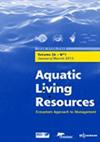Impacts of COVID-19 on small-scale freshwater carp and coastal brackish water shrimp farming in India
IF 1.9
4区 农林科学
Q3 FISHERIES
引用次数: 0
Abstract
The present study was simultaneously conducted in two distantly located areas to assess the impacts of COVID-19 on farming processes, instantaneous financial impacts and mitigation strategies adopted by the farmers in the small scale freshwater carp farming and coastal brackish water shrimp farming sectors in India. Primary data were collected through interview of the farmers with the help of pre-tested structured interview schedules. Though the initial impact in both the sectors were substantial, freshwater carp farmers mitigated the crises comparatively well because of wider option in alternative livelihood, low cost locally available inputs, mobilization of local market, direct door to door vending of live fish and mobilization of women work force from the family in the farming sector. Untapped resource in the form of women's' participation in the freshwater farming practices was noteworthy during the pandemic period which increased polynomially (y = –1.0714x2 + 7.5286x − 2.2; R2 = 0.9648). As the shrimp farming sector was dependent upon external markets and burdened with high cost inputs primarily supplied by the input dealers on credit basis, the sector has to bear the burden most. Garret's Rank analysis revealed that integration with other production sectors ranked first as mitigation perception to the freshwater carp farmers, whereas, to the coastal shrimp farmers, the highest rank was with the perception that everything will be normalized within 2–3 months naturally. Garret's Rank analysis also revealed that in both the sectors, the farmers most important need was credit from the Govt. source in mitigating COVID-19 like crisis in future.
2019冠状病毒病对印度小规模淡水鲤鱼和沿海咸淡水虾养殖的影响
本研究同时在两个偏远地区进行,以评估2019冠状病毒病对印度小规模淡水鲤鱼养殖和沿海咸淡水虾养殖部门的养殖户所采取的养殖过程、即时财务影响和缓解战略的影响。初步资料的收集是通过对农民的访谈,并借助预先测试的结构化访谈时间表。虽然对这两个部门的最初影响都很大,但淡水鲤鱼养殖户相对较好地缓解了危机,因为他们有更广泛的替代生计选择、当地可获得的低成本投入、动员当地市场、直接挨家挨户地出售活鱼以及动员家庭妇女劳动力从事农业部门。值得注意的是,在大流行期间,妇女参与淡水耕作方式的未开发资源呈多项式增长(y = -1.0714x2 + 7.5286x−2.2;r2 = 0.9648)。由于对虾养殖部门依赖于外部市场,并负担着主要由投入品经销商以信贷方式提供的高成本投入品,因此该部门承担的负担最重。Garret的Rank分析显示,与其他生产部门的整合对淡水鲤鱼养殖户的缓解感知排名第一,而对沿海虾养殖户来说,排名最高的是对一切将在2-3个月内自然正常化的感知。Garret的Rank分析还显示,在这两个领域,农民最重要的需求是来自政府的信贷,以缓解未来的COVID-19危机。
本文章由计算机程序翻译,如有差异,请以英文原文为准。
求助全文
约1分钟内获得全文
求助全文
来源期刊

Aquatic Living Resources
农林科学-海洋与淡水生物学
CiteScore
2.30
自引率
0.00%
发文量
10
审稿时长
>24 weeks
期刊介绍:
Aquatic Living Resources publishes original research papers, review articles and propective notes dealing with all exploited (i.e. fished or farmed) living resources in marine, brackish and freshwater environments.
Priority is given to ecosystem-based approaches to the study of fishery and aquaculture social-ecological systems, including biological, ecological, economic and social dimensions.
Research on the development of interdisciplinary methods and tools which can usefully support the design, implementation and evaluation of alternative management strategies for fisheries and/or aquaculture systems at different scales is particularly welcome by the journal. This includes the exploration of scenarios and strategies for the conservation of aquatic biodiversity and research relating to the development of integrated assessment approaches aimed at ensuring sustainable and high quality uses of aquatic living resources.
 求助内容:
求助内容: 应助结果提醒方式:
应助结果提醒方式:


